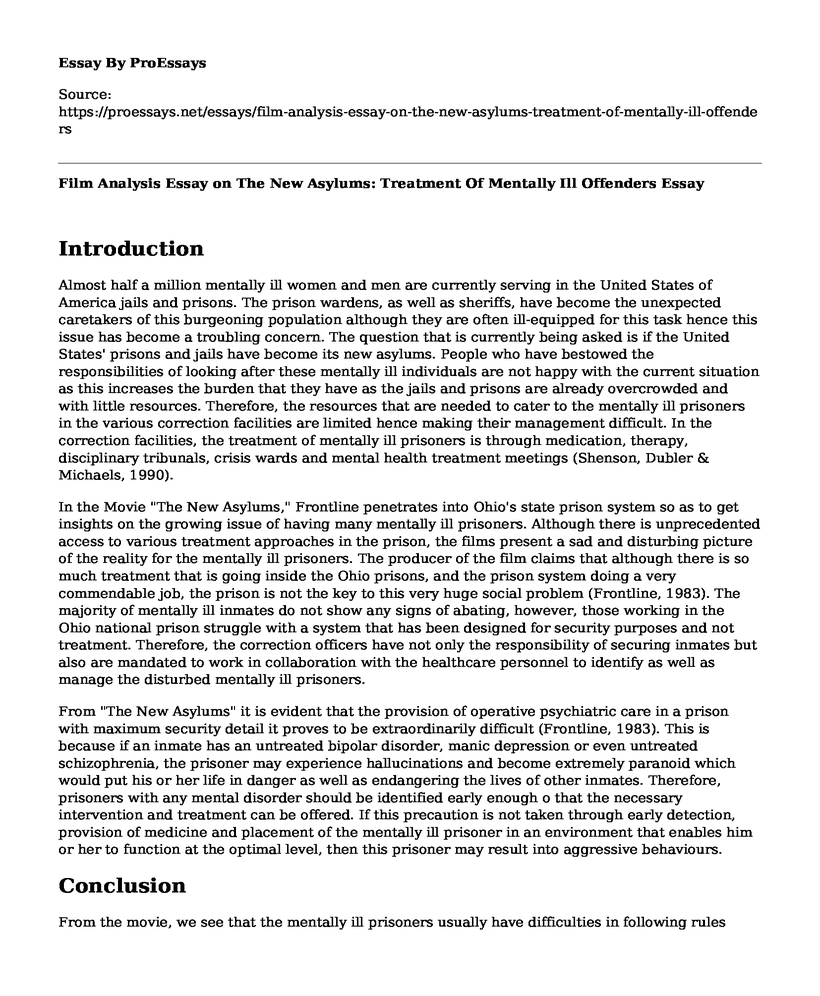Introduction
Almost half a million mentally ill women and men are currently serving in the United States of America jails and prisons. The prison wardens, as well as sheriffs, have become the unexpected caretakers of this burgeoning population although they are often ill-equipped for this task hence this issue has become a troubling concern. The question that is currently being asked is if the United States' prisons and jails have become its new asylums. People who have bestowed the responsibilities of looking after these mentally ill individuals are not happy with the current situation as this increases the burden that they have as the jails and prisons are already overcrowded and with little resources. Therefore, the resources that are needed to cater to the mentally ill prisoners in the various correction facilities are limited hence making their management difficult. In the correction facilities, the treatment of mentally ill prisoners is through medication, therapy, disciplinary tribunals, crisis wards and mental health treatment meetings (Shenson, Dubler & Michaels, 1990).
In the Movie "The New Asylums," Frontline penetrates into Ohio's state prison system so as to get insights on the growing issue of having many mentally ill prisoners. Although there is unprecedented access to various treatment approaches in the prison, the films present a sad and disturbing picture of the reality for the mentally ill prisoners. The producer of the film claims that although there is so much treatment that is going inside the Ohio prisons, and the prison system doing a very commendable job, the prison is not the key to this very huge social problem (Frontline, 1983). The majority of mentally ill inmates do not show any signs of abating, however, those working in the Ohio national prison struggle with a system that has been designed for security purposes and not treatment. Therefore, the correction officers have not only the responsibility of securing inmates but also are mandated to work in collaboration with the healthcare personnel to identify as well as manage the disturbed mentally ill prisoners.
From "The New Asylums" it is evident that the provision of operative psychiatric care in a prison with maximum security detail it proves to be extraordinarily difficult (Frontline, 1983). This is because if an inmate has an untreated bipolar disorder, manic depression or even untreated schizophrenia, the prisoner may experience hallucinations and become extremely paranoid which would put his or her life in danger as well as endangering the lives of other inmates. Therefore, prisoners with any mental disorder should be identified early enough o that the necessary intervention and treatment can be offered. If this precaution is not taken through early detection, provision of medicine and placement of the mentally ill prisoner in an environment that enables him or her to function at the optimal level, then this prisoner may result into aggressive behaviours.
Conclusion
From the movie, we see that the mentally ill prisoners usually have difficulties in following rules hence they end up spending much of their time in solitary confinement hence become deprived of their social interactions. The prison officers use solitary confinement as a treatment and a management mechanism. However, these kinds of punishments do not work but worsen the situation as the mentally ill prisoner is left undiagnosed with the underlying condition hence no treatment given. This is true because, from the perspective of a mentally ill individual, placement in a solitary situation is worse than being taken from the society and placed in a prison. Eventually, most of the mentally ill prisoners are released back into the society with limited medication, little preparation and no family or support structure. Therefore, programs should be formulated to guide the mentally ill prisoners released from prison (Torrey, E. F., Kennard, Eslinger, Lamb & Pavle, 2010).
References
Frontline, (1983). The New Asylums. Movie. Available Online At https://www.imdb.com/title/tt0874008/ Retrieved On September 8, 2018
Shenson, D., Dubler, N., & Michaels, D. (1990). Jails and prisons: the new asylums?. American Journal of Public Health, 80(6), 655-656.
Torrey, E. F., Kennard, A. D., Eslinger, D., Lamb, R., & Pavle, J. (2010). More mentally ill persons are in jails and prisons than hospitals: A survey of the states. Arlington, VA: Treatment Advocacy Center.
Cite this page
Film Analysis Essay on The New Asylums: Treatment Of Mentally Ill Offenders. (2022, Aug 03). Retrieved from https://proessays.net/essays/film-analysis-essay-on-the-new-asylums-treatment-of-mentally-ill-offenders
If you are the original author of this essay and no longer wish to have it published on the ProEssays website, please click below to request its removal:
- Critical Essay on Odyssey of the People
- Visual Analysis of a Pictorial Narrative Essay
- Self-Assessment Paper Example
- Case Study on Moral Status Paper Example
- The Kings and Queens: Nurturing Talent Through Music Performance - Essay Sample
- Stigma & Mental Illness: Impacts & Discrimination - Essay Sample
- Analyzing "A Heart Worn on My Hand" - Free Paper Example







